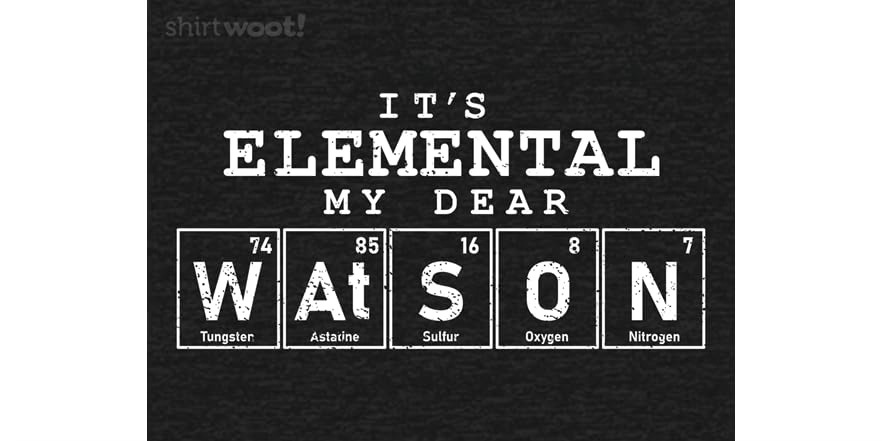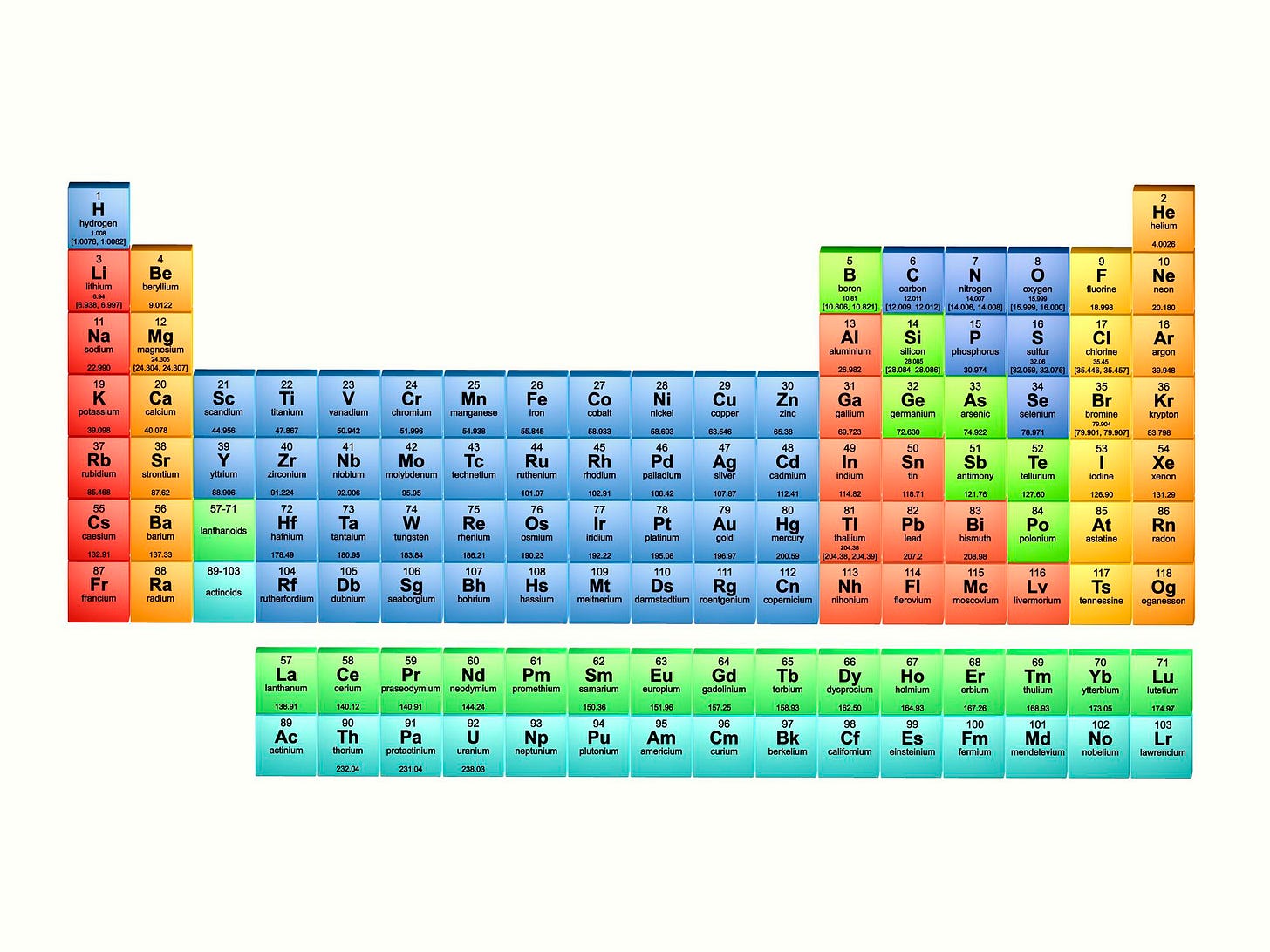It's Elemental, My Dear Watson: Magnesium
By John Ortiz, edited by Jonathan Atleson
One of the greatest discoveries in science, in my opinion, is the periodic table. I have a poster of it hanging in my office. I’ve been known to stare at it, ahem, periodically, wondering what secrets it can reveal.
In my case, I tend to focus on biological sciences, health, and energy. Did you know 99% of the human body is composed of just six elements?
First, think about the macronutrients: fats, proteins, and carbohydrates. All three contain carbon, hydrogen, and oxygen. In addition, proteins have nitrogen. The old adage you are what you eat is literally affirmed by this.
For the other two elements, think about bone formation and strength. That would be calcium and phosphorus. That's 99% of your body right there.
The majority of the last 1 percent, I call the electrolytes. This would be comprised of sodium, potassium, chlorine, sulfur, and magnesium.
Then we have what I called the nine important micro-elements of importance. That would be comprised of iodine, selenium, zinc, silica, gold, silver, and copper.
At the start of the 20th century, the problem civilization had was depleted soils due to industrial farming. This was partly resolved by a German chemist, Fritz Haber, who developed fertilizer.
(That’s the good part of his history. The bad part: he’s also the “father of chemical warfare,” having developed the deadly chlorine gas used in the trenches of World War I.)
The collection of elements with which Haber supplemented his soil is known as “NPK,” which stands for nitrogen, phosphorus, and potassium. What was missing, in my opinion, was magnesium.
Two books that transformed me and my thinking about health and wellness were:
The Magnesium Miracle by Carolyn Dean, M.D. N.D.
The Calcium Lie II: What Your Doctor Still Doesn’t Know by Robert Thompson M.D. and Kathleen Barnes (this is the updated edition; the original edition was published in 2008)
Magnesium supplementation should be on every American's mind. It is estimated that 80% of Americans are deficient in magnesium. If this is true, the medical establishments owes us some answers: How did it happen? What is the cost and significance of this? Why don't most Americans know about it?
I think the answer — that we’ll never get — is: money. The apostle Paul once said, “The love of money is the root of all evil.” We need to evaluate science, medicine, and research in this country through the prism of money. Who paid for the research? Who will profit from the research? Who controls the framing and sharing of the results with the public?
Surely, we can determine our own magnesum level by doing a standard blood test! Well…it’s a little more complicated than that, I’m afraid!
You see, in physiology, we have intracellular, which is inside the cell, and extracellular, which is outside the cell. 99% of the magnesium in your body is intracellular.
But the majority of tests measure extracellular magnesium. So you’re only measuring 1% of your magnesium when you take a standard blood test! Measuring 1% of your magnesium doesn't really tell you anything. Not surprisingly, most patients test normal.
If I were trying to get a true reading of magnesium levels, I would want to look where the 99% is, not the 1%.
The RBC magnesium test — available by special request — measures intracellular magnesium in your red blood cells. It turns out that the 80% of people with low magnesium levels are low in intracellular magnesium.
Foods containing high levels of magnesium include the dark green leafy vegetables as well as seeds and nuts. I suppose 80% of the population could eat more of them and see if that helps. Good luck with that!
But there are additional problems. One is that the soil today is said to be low in magnesium. A hundred years ago, the magnesium levels in soils were supposedly much higher, and therefore, all the foods that came from those soils would much be higher in magnesium as well. The foods your grandparents ate were presumably much higher in magnesium than the foods that you are eating. If this is true, magnesium should be added into the fertilizer. (Organic produce sidesteps some of these issues.)
The next problem is compromised guts, also known as “leaky.” We used to talk about someone having a “cast iron stomach.” Millennials don't even know the term. (Of course that’s partially their stomachs and partially that cast iron has fallen out of use.) It meant that you could eat anything, digest it, and ultimately absorb it.
But today, most people have compromised guts, and therefore compromised absorption. There can be a dramatic difference between what you consume and what you absorb. This includes getting magnesium from plants, from animals, or from synthetic supplements.
What are the ramifications of being low in magnesium? Well, 400 different enzymatic functions rely on magnesium to do their thing. Did you know that you need magnesium to absorb calcium for strong bones and teeth?
Plus, if you take too much calcium alone, without magnesium, your kidneys will flush out the magnesium along with the excess calcium. Also, if you eat too much sugar, you flush magnesium. If you're under stress, you flush magnesium. And if you exercise excessively and sweat, you flush magnesium.
So one might ask, where did the distortion in our calcium/magnesium ratio begin? Well, it all started with Eve’s nipple, so to speak. You see, mammalian milk is 10 parts calcium to 1 part magnesium. This is the first food for most mammals, so Science concluded it must be the optimal ratio: 10 to 1.
Now, it may be the optimal ratio for infants to grow muscle and bones, but the optimal amount changes as we grow and age. Perhaps you’ve noticed that most people become lactose intolerant after they stop growing. Coincidence?
Magnesium is the mineral for muscular relaxation. So a charliehorse or a cramp, including the menstrual variety, is partly due to too much calcium and not enough magnesium.
This becomes paramount in the most important muscle of your body, your heart. I often wonder, could a heart attack be a muscle cramp of the heart due to restricted blood flow and magnesium deficiency? It’s relevant to note that the highest levels of magnesium are found in the thoracic cavity near the heart.
Then there is the brain. Magnesium deficiency manifests as anxiety, depression, insomnia, and behaviors associated with ADHD, addiction, and aggression. From Big Pharma's point of view, these are all huge cash cows. Get the picture?
Speaking of behaviors, when you do an analysis of the most violent inmates in prison, compared to the overall prison population, they test the most deficient in magnesium. And when you supplement them with magnesium, they become less violent. So the question is, how many people in the US — which dominates the worldwide prison population — are incarcerated partially or mainly due to magnesium deficiency?
Well then, what do you do if you are both magnesium deficient — like 80% of the population — AND have a compromised gut — which I believe most people do. Well, I would start with aloe vera gel, which you can read about in this article. Then take a bath…but not an ordinary one….
Naturopaths love baths in Epsom salt, which is actually magnesium sulfate. Now, some people love to take baths and others don’t. Some people have bathtubs and others don't. Some people can't because of physical limitations or they might have a septic tank, which would be ruined by the magnesium sulfate (it would kill the bacteria used).
If you are financially comfortable, you might consider trying a flotation tank of Epsom salts. My good friend has a business called Peak Performance Float in Walnut Creek. You can float in something akin to a bathtub in an open room. Or, for the maximalist, you can disappear into a pod-like tub for the full sensory deprivation experience. It’s the ultimate Epsom salt bath, because you’re actually floating on 2000 pounds of Epsom salt!
In my personal opinion, “floating” is a wonderful experience — if you can afford it. But part of the Triad Healing philosophy is “Affordable,” and that means different things to different people. We like to say, “You don’t have to be well-heeled to be well and healed.”
The biohack I developed, if you want to be frugal — or as Jonathan calls it, cheapskate — is one tablespoon of Epsom salt in a cup of water. You put that in a spray mister and you can spray yourself multiple times a day wherever it hurts. Be careful if you have an open wound because it will sting. And you can do this as often as you like. It feels and goes on like water. This has 10 times the concentration of a normal Epsom salt bath and you can do it for pennies a day. I guess you can call it “pennies from heaven.”
I will discuss other elements in future posts, but I consider magnesium to be the most important one for everyday health and wellbeing. One day, instead of saying “chill out,” we may be saying, “mag in.”










I'm always glad when I see anyone getting the word out about magnesium. Anyone with an arrhythmia or high blood pressure should first try a 5 mg IV of magnesium, to see if the problem either doesn't go away or gets a whole lot more manageable.
My personal magnesium deficiency test: if you have a noticeable heartbeat without strenuous exercise (think heart palpitations, pounding heartbeat, that sort of thing), your magnesium levels are low.
You might be interested in reading my heart story, with a magnesium connection. It illustrates the incredible intelligence of the human body. I suspect there aren't very many people who have had the experience I've had. Those with my symptoms typically get sucked into the medical system and either undergo risky procedures, or are put on drugs for life (and become cardiac cripples). I avoided all of that.
https://eclectichealing.substack.com/p/not-your-typical-heart-disease-story?r=1azvtv
Magnesium chloride flakes are better absorbed than Epsom salts. Magnesium oil is the liquid form available as a spray, and it is a great way to quickly get more magnesium on board.
Another thing to consider is ozonated magnesium for tuning up the gut. I'm using this now, so it will be a few days before I know how well it works. The ozone oxidizes most bad bacteria and is said to get rid of biofilms and mucoid plaque. I had wanted to try Homozon, but it looks like the FDA might have shut them down last fall, so I'm using Super OxyFlush.
Three days into the protocol I had an amazing side benefit, which I'll write about in the future. In my mind, only cures have side benefits, so I'm very optimistic about how I'll do once I complete the current protocol.
Another electrolyte found mostly in extracellular fluid is sodium. Most of us are salt-starved due to misguided advice from the government. A lot of skin problems will resolve with adequate salt intake.